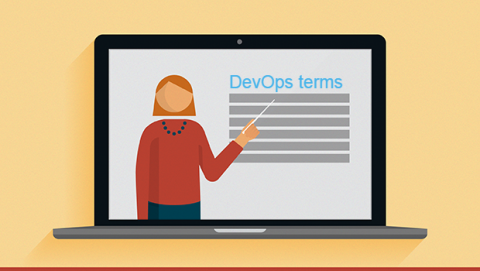If you are new to DevOps, the lingo can get confusing pretty quickly. Terms like DevOps and agile are sometimes used interchangeably. Some concepts, like continuous delivery and continuous deployment, are often referred to in acronym form, which, unhelpfully, are both “CD.” Terms like automation can have a fairly simple or complex definition, depending on who you are speaking to.
As DevOps plays a bigger role in your organization, it’s helpful for teams to be on the same page regarding how people define its basic concepts.
10 DevOps terms to know, in plain English
Here’s a primer on 10 essential terms you’ll need to know – whether you are new to DevOps or you want to bring a new team member up to speed quickly. We've also highlighted some sticky spots for newbies – terms that are often confused, and alternative names for the same concept.
[ Need to explain key DevOps terms to others? Get our downloadable cheat sheet: DevOps Glossary. ]
1. DevOps
“DevOps is not about a single role or position, but about how you approach and control the development process. DevOps practices describe and systematize the development process in order to build, test, and deliver with better speed and reliability.” – Maksym Kunytsia, chief product officer, Chanty
If you need a quick sound bite or way to help you explain DevOps, you can borrow one of these plain-English analogies.
2. Agile
“Agile is a set of four value statements and 12 principles that originally described a better way of developing software. The Agile Manifesto was conceived in 2001 by 17 leading practitioners of new methodologies. Agile is not a methodology but a mindset. It represents a way of working that incorporates the principles of collaboration, systems thinking, and empowerment.” – Alan Zucker, founding principal, Project Management Essentials
DevOps vs. Agile:
Sometimes the terms DevOps and agile are used interchangeably. While they do have a shared past, there are fundamental differences between the two. You can think of the two in racing terms, suggests Eran Kinsbruner, chief evangelist for Perfecto.
“Agile can be the racing car driver aiming to drive as fast as possible, while DevOps is the entire team that supports the driver to reach his goal, including the mechanic guys, operations, coach, etc.,” says Kinsbruner. “Agile is about releasing fast while getting customer feedback, DevOps is about getting internal feedback while delivering fast through cross-team collaboration, best practices, and alignment toward meeting business goals.”
[ Want help explaining this to others? Read also: Agile vs. DevOps: What’s the difference? ]
3. Continuous Delivery/Continuous Deployment (CD)
"CD has two different meanings, which can be confusing. It refers to continuous delivery and continuous deployment. Continuous delivery refers to continuous delivery of value; it is a foundational agile and DevOps principle. Continuous deployment is using automation tools to allow organizations to quickly deploy software into production. By automating the software development value stream, organizations can significantly reduce the amount of time it takes to develop, test, and deploy into production, which enables continuous delivery of value.” –Alan Zucker, founding principal, Project Management Essentials
4. Continuous Integration (CI)
“This technique continuously merges source code updates into one mainline to prevent merge conflicts by integrating code from different developers as soon as it’s available. It creates a real-time window into the current state of the software system and quality measurements, enabling constant engagement of all DevOps team members. For security teams, CI creates an opportunity to enforce secure coding practices and vulnerability assessment early in the software development lifecycle.” – Rani Osnat, VP strategy, Aqua Security
5. Automation/Automated Builds
“Automated builds enable DevOps to compile source files, package compiled files into compressed formats, and produce installers. Repeatable build steps can be done with no information other than stored source code that is then automated.” – Rani Osnat, VP strategy, Aqua Security
Taking it further:
“Automation is not just about using tools to do repeated tasks. The science of doing automation right is all about ensuring that the right processes are being executed the right way. Automation of the wrong processes or processes being executed the wrong way only creates more problems. The science of automation can also be applied to business processes. Automation must be done in increments across logical subsets of process steps that are part of a continuous engine.” – E.G. Nadhan, chief architect and strategist, North America commercial, Red Hat






